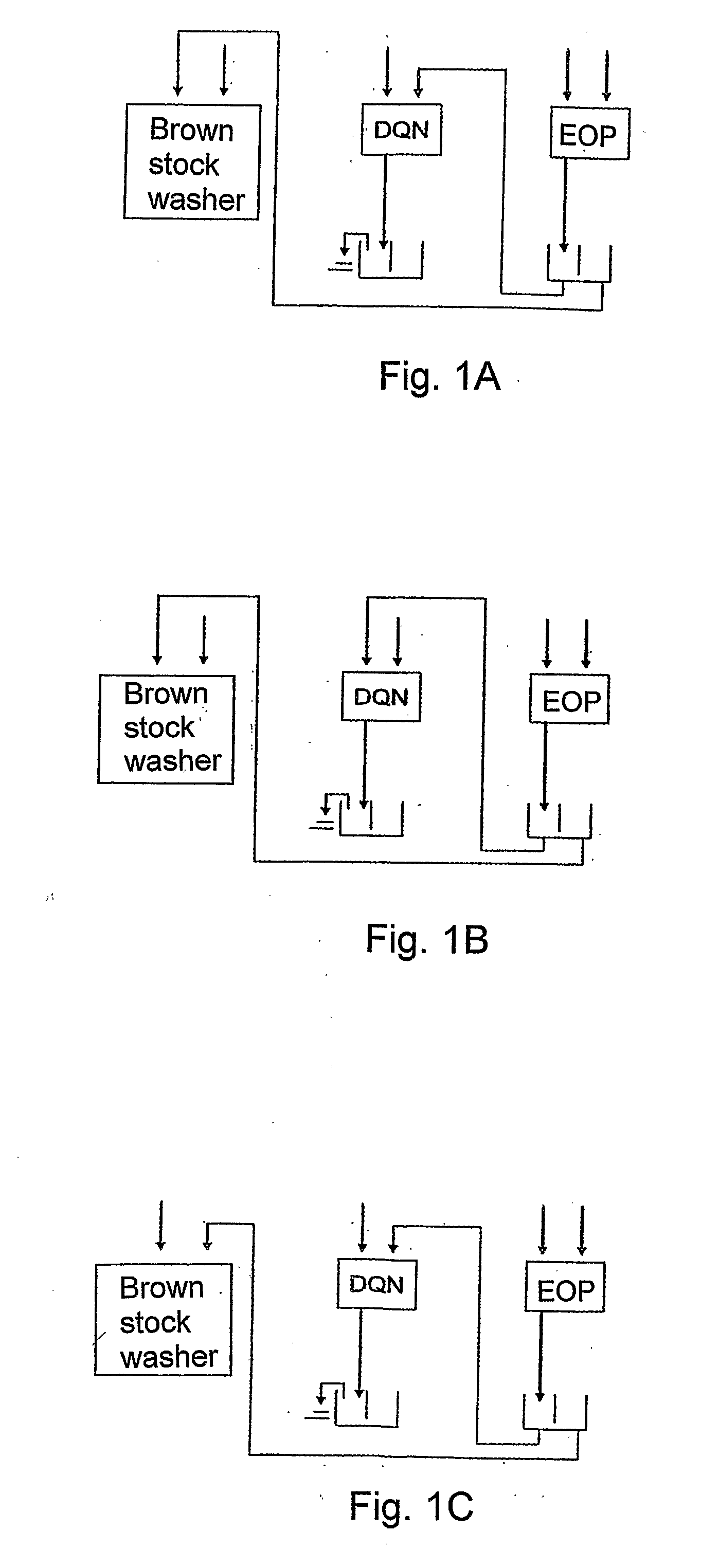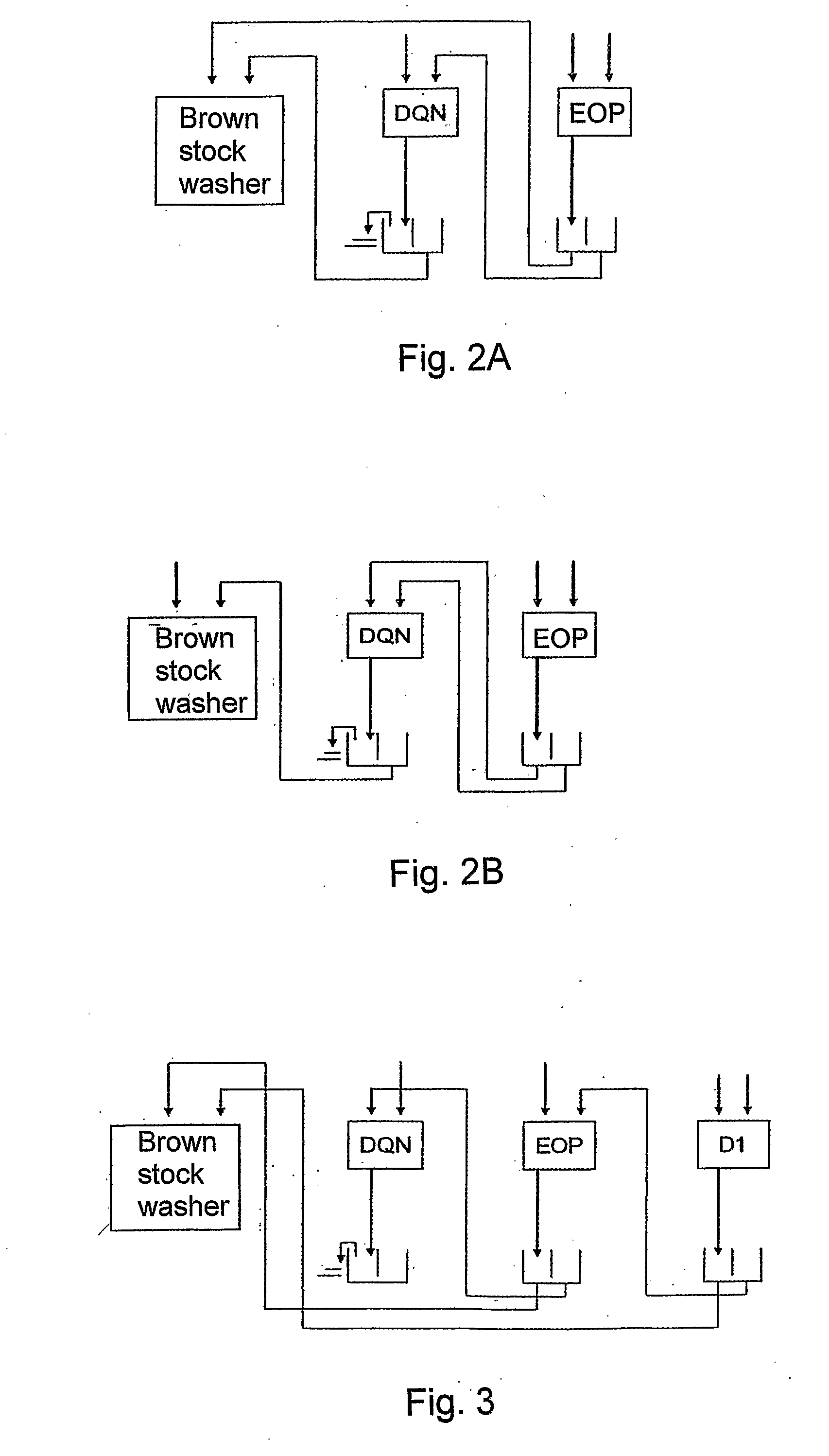[0012]A chelating agent is added prior to or especially subsequent to the
chlorine dioxide treatment or between two
chlorine dioxide treatments. In this context, an expression DQ is used for the chlorine dioxide stage, in connection with which the chelation is carried out in the above-mentioned manner, irrespective of the addition sequence of the agents. The chelation stage (Q) is not separated from the D0 stage with an intermediate washing step. The chelating pH is from 2 to 7. Alkali is added to the pulp subsequent to the chelation and the chlorine dioxide treatment in the same stage for raising the pH of the pulp to above 7 and at most to 12 prior to a following stage, washing, in order to dissolve
organic matter. The treatment according to the invention intensifies the effectiveness of the following bleaching stages, reduces the consumption of bleaching chemicals, especially in the initial bleaching, except for alkali, and improves particularly the utilization of the filtrates resulting from the alkaline stage following the DQN stage in washers.
[0013]When chlorine dioxide reacts, components of the pulp binding metals, such as hexenuronic acid groups, are degraded, thus facilitating removal of metals. The rise of the pH after the chelation does not impair the removal of metals in a washing step following said stage, because a resulting chelate-
metal-complex is sufficiently stable. The rise of pH to be neutral or alkalic after chelation increases the amount of dissolved
organic matter, enabling thus free
metal ions to be attached to the dissolved matter and not to the fibres.
[0014]The object of the present invention is to improve the removal of reacted
organic matter in a first chlorine dioxide stage and to reduce the amount of chlorine compounds being passed to a following bleaching stage. At the same time, reduction of the content of the transition metals contained in the pulp or a substantial removal thereof is ensured by chelating the pulp under optimal conditions, enabling thus a greatest possible amount of the transition metals (Mn, Fe and Cu) to be chelated, while a significant part of alkaline earth metals (Mg, Ca) will remain in the pulp. Thereby the effectiveness of the following bleaching stages will be intensified, and the
recovery and
usability of the filtrates resulting from them for other pulping processes, such as for washing of brown stock and in different bleaching stages will be improved.
[0017]In the process according to the invention, the chlorine dioxide treatment of the initial bleaching can be carried out under conditions of a conventional D0 stage. In the process according to the invention, the
retention time in the chlorine dioxide stage of the DQN stage is from 10 sec to 120 min, preferably from 1 to 30 min, most preferably from 1 to 15 min, the active chlorine dosage (kg / adtp) is about 2 to 2.5 times the
kappa number or from 10 to 60 kg as active chlorine per
ton of air dry pulp (hereafter expressed as kg act. Cl / adtp), preferably from 15 to 60 kg act. Cl / adtp, most preferably from 20 to 50 kg act. Cl / adtp, the final pH is from 1 to 5, preferably from 2 to 3.5, and the thickness is from 1 to 40%, preferably from 3 to 12%. Air dry pulp means in this context a pulp, having a
dry matter content of 90%. The temperature is preferably from 50 to 100° C., especially from 60 to 95° C. The neutralizing or alkalizing steps carried out after the addition of chlorine dioxide and the chelation lowers the
kappa number and improves the effectiveness of the following bleaching stages, reducing thus the consumption of the chemicals in the bleaching. In the first chlorine dioxide stage of the bleaching, the dosage of the chemicals can be reduced, if desired. When the required chemical dosage is smaller, the charged chlorine dioxide is consumed very rapidly and the required retention in the chlorine dioxide treatment is decreased. The decreased need of chlorine dioxide results in a decrease of the need to adjust pH in the Q stage as well as the consumption of alkali in the alkalizing following the DQ treatment. In said D treatment of the DQN stage the pulp may, in addition to chlorine dioxide, be treated also with
ozone,
peracetic acid or caron acid or a combination of these.
[0020]After the chlorine dioxide and chelation stage, alkali is added to the pulp prior to the washing step in order to neutralize or alkalize the pulp prior to the washing. Differing from a conventional alkali treatment separated with washing or displacement, the alkalization according to the invention carried out prior to washing does not aim at an effective alkali stage, such as a second stage EOP of initial bleaching but also a mild treatment is sufficient. After the addition of alkali (N) in the DQN stage, the pH is above 7. Said pH after the addition of alkali is preferably at most 12, in one embodiment especially at most 10. Generally, good results are obtained by a pH value of from 8 to 11. In one embodiment said pH is above 10, but at most 12. When the pH is above 10, the content of the organic chlorine compounds (AOX) generated in the chlorine dioxide treatment begins to decrease due to their degradation, resulting in a decrease of the
toxicity of the effluents resulting from the stage. A suitable alkali dosage is preferably from 1 to 20 kg alkali as NaOH /
ton of air dry pulp (kg as NaOH / adtp), preferably from 1 to 15 kg as NaOH / adtp. The
effective time is from 5 sec to 60 min, preferably from 40 sec to 15 min, the temperature is from 50° C. to 100° C., preferably from 60 to 95° C. and the thickness is in conformity to the preceeding treatment. A rise of the pH and the temperature or an increase of the
retention time will result in an increase of the lowering of the
kappa number, but the consumtion of alkali increases correspondingly. By the alkali treatment, the organic material reacted during the chlorine dioxide treatment and the
chloride bound thereto are dissolved from the pulp, and are removed in the washing step following the DQN stage. Thereby the content of dissolved matter of a following bleaching stage, preferably the EOP stage, will decrease and its effectiveness will be improved. The removal of metals from the pulp will not be impaired, although the pH of the pulp is raised higher than an optimal chelating pH after the addition of a chelating agent prior to washing.
[0024]When using
white liquor or oxidized
white liquor for alkalizing the pulp in the DQN stage, the Na / S balance of the chemical cycle can be adjusted in a new way, and foreign matters present in the
white liquor, such as Al, Cl, K and Si can be removed. A decrease in the consumption of
sodium hydroxide in the EOP stage reduces the influence on the Na-balance of a mill, if the filtrates are conducted to the
recovery via brown stock washing.
 Login to View More
Login to View More 


